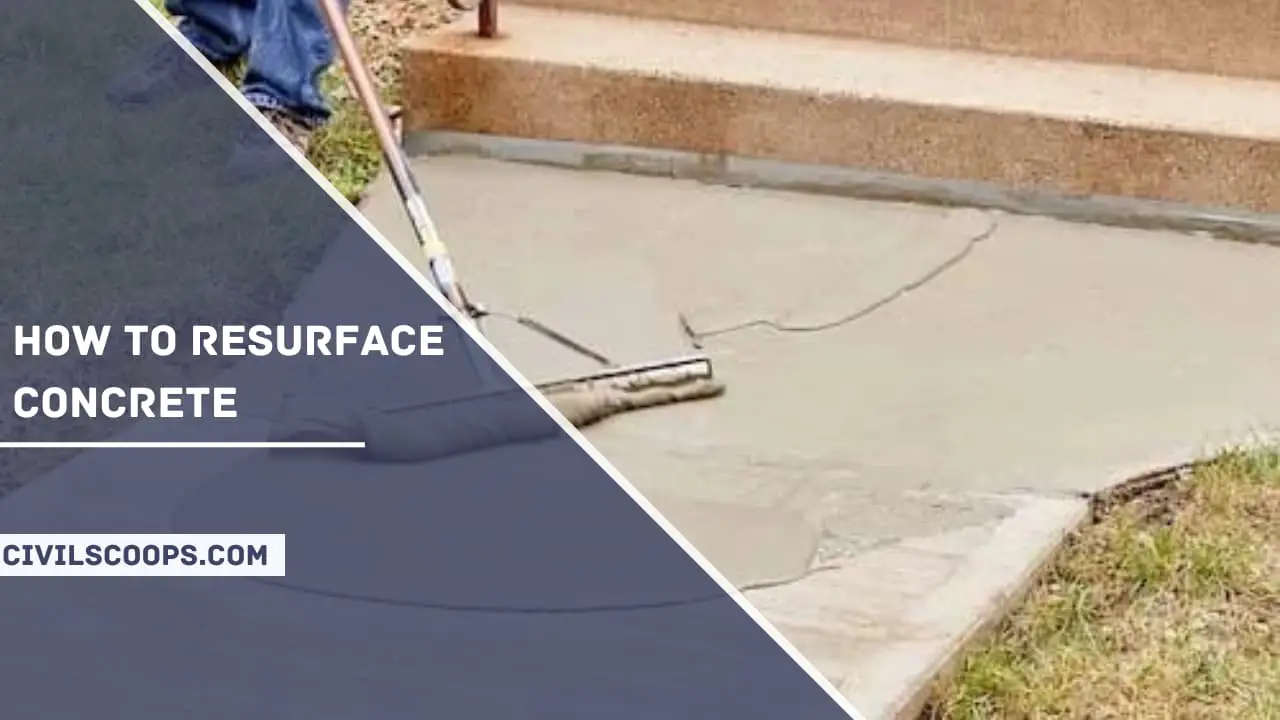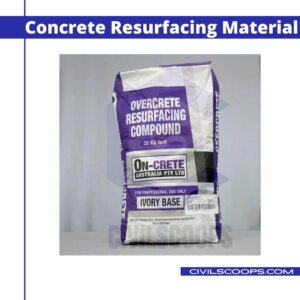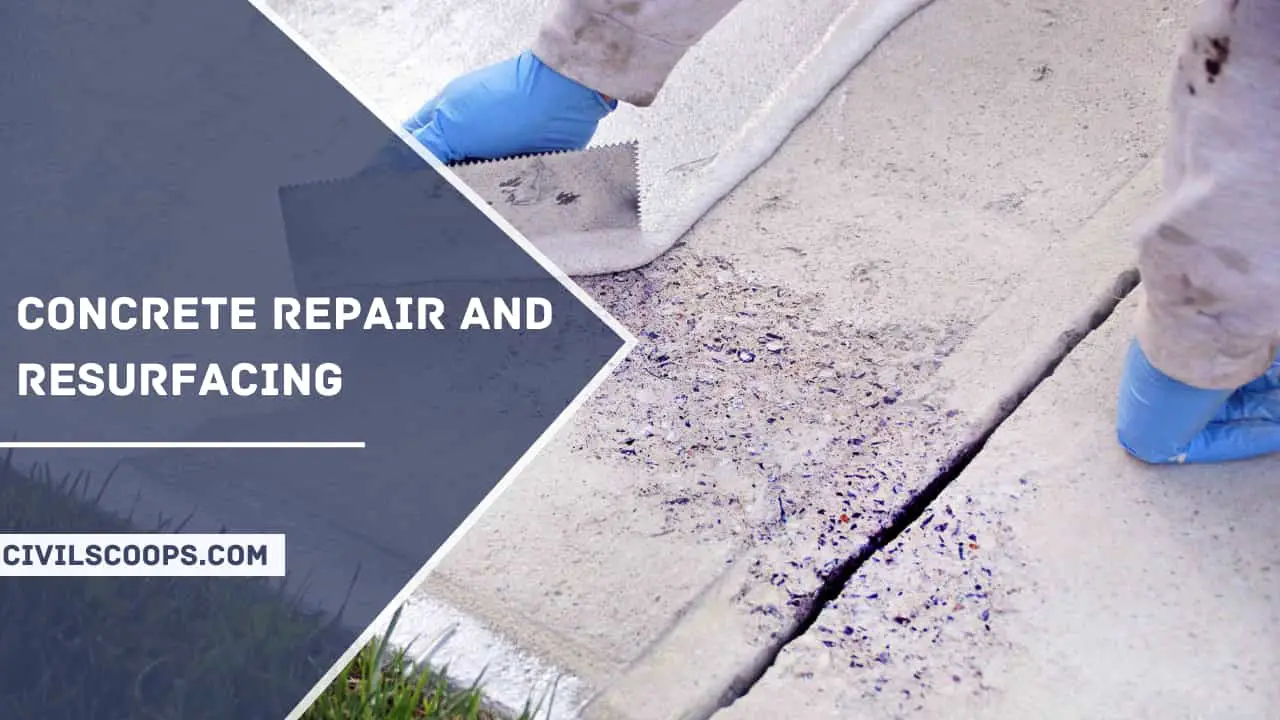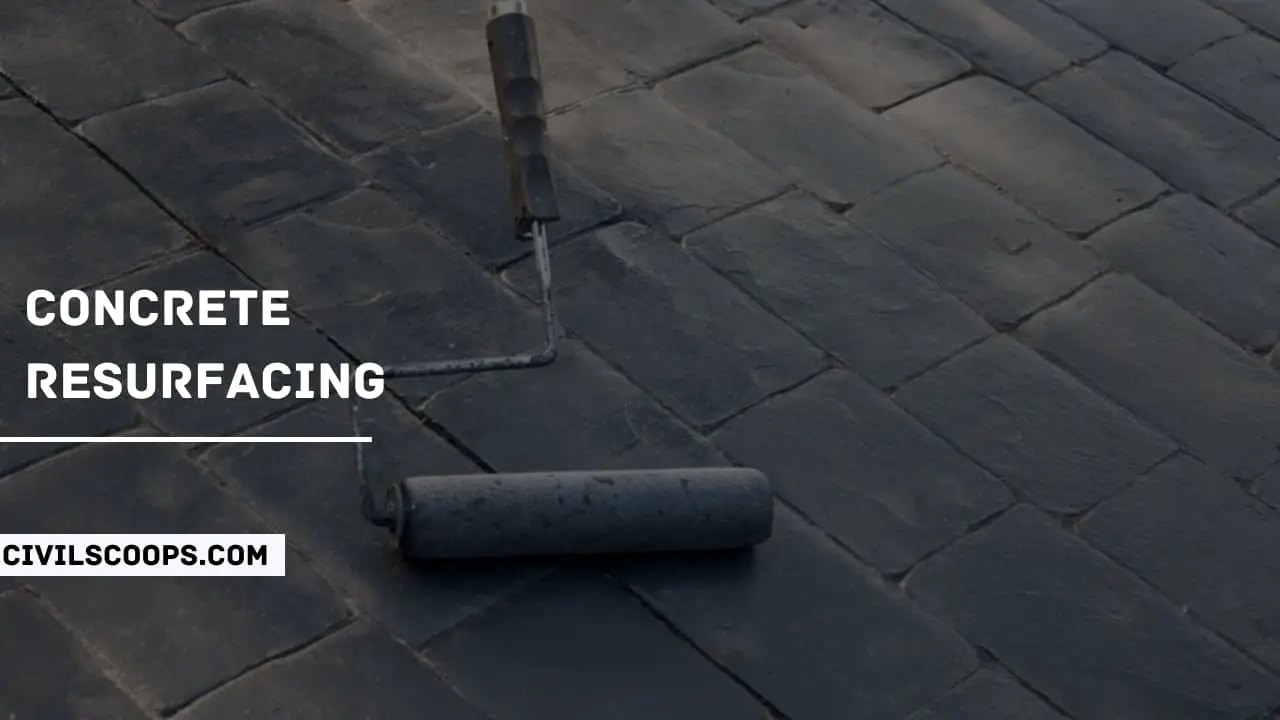What Is Concrete Resurfacing | How to Resurface Concrete | Concrete Resurfacing Material | Concrete Repair and Resurfacing

Table of Contents
What Is Concrete Resurfacing?
Concrete resurfacing is the process to provide a brand new look to damaged concrete. In the process of resurfacing of concrete, a concrete coating is applied on the surface of existing concrete.
Concrete resurfacing is a time-consuming process, and it’s very much labour-intensive process so, it’s a little bit expensive also. In this process, a special bonding agent is added to the cement mixture to get a smooth cementing surface.
Types of concrete resurfacing
- Stamped Overlays
- Pool Deck Resurfacing
- Concrete Crack Repair
- Driveway Repair
- Resurfacing Patios
- Resurfacing Products
How to Resurface Concrete?

There are generally four steps of resurfacing concrete, those are
1. Concrete Cleaning
Concrete cleaning is done by a mechanical machine of high pressure of near about 3500 psi. This process is done to remove dust, algae and other hazardous materials because a cleaned surface has a better power of bonding with new materials.
2. Patch Spelled Areas
In damped concrete, resurfacer is used to fill those patches. Resurfaced is made by one part of water with seven-part of resurfaced in a five-gallon bucket. Then we need to fill up that place and smooth the area with a trowel.
3. Spread the Resurfacer
Walkway joints are filled with resurfaced. The resurfaced is only workable for 20 minutes.
4. Trowel Operation
Trowel operation is done to spread the resurfaced. The thickness of the resurfacer is ¼ to ⅛ inch. We need a total of six hours to use it again.
Concrete Resurfacing Material

The general materials of resurfacing concrete are a unique blend of portland cement, sand, polymer modifiers, many other additives. This is mainly used to repair shrinkage cracks, thin repairs, etc. A fair concrete resurfacing material is defined by its flexibility, sprayable, easy for trowel operation, etc.
Here are some conditions of resurfacing concrete before we purchase it from the market-
- It must be water-resistant
- It must be non-slippery
- It should be UV resistant
- It should have the ability to withstand the freeze that cycle
- It should have the ability to resistant against chemicals
- It should have the ability to overcome the heavy foot and vehicle traffic.
Now some readymade products are available in the marketplace, those are
- Overlay Mix
- MT resurfacer
- Overlay foot mixes
- Versa-Crete resurfacer smooth mix
- Floor top STG
- Top Cap resurfacer
Concrete Repair Vs Resurfacing

Concrete Repair
Concrete repair is a process where we fix the problem of the concrete internally. There are several types of concrete repair techniques available, they are
- Epoxy Injection
- Routing and Sealing of Cracks
- Stitching
- Grouting Method
1. Epoxy Injection
Epoxy injection is a type of concrete repair process. It’s applied where the concrete cracks are not more than 0.002 inches or 0.05 mm.
In this process, epoxy resins are entered into the cracks and exposed on the concrete surface. Epoxy injections are used in building cracks repairing, dams, bridges and other structures. Epoxy resin techniques need a high skill full labours.
2. Routing and Sealing of Cracks
Routing and sealing are applied where structural repair is not applied. This is applied where cracks are in the face of the concrete. Sealing is useful in a plane surface than a curved surface.
The materials used in sealant are epoxies, urethanes, silicone, polysulphide, asphaltic material, polymer mother, etc.
3. Stitching
Stitching is another method of concrete repair technique. In this process, two holes are drilled in both sides of the concrete cracks. After that, steel bars are used to maintain the crack.
4. Grouting Method
In the gravity dam, wide cracks are developed in the dam’s wall. This process is by Portland cement grout. This method is very effective to prevent water leaks.
Concrete Resurfacing

Concrete resurfacing is the process to provide a brand new look to damaged concrete. In the process of resurfacing of concrete, a concrete coating is applied on the surface of existing concrete.
Concrete resurfacing is a time-consuming process, and it’s very much labour-intensive process so, it’s a little bit expensive also. In this process, a special bonding agent is added to the cement mixture to get a smooth cementing surface.
Types of Concrete Resurfacing
Here, different types of concrete resurfacing are as follows.
- Stamped Overlays
- Pool Deck Resurfacing
- Concrete Crack Repair
- Driveway Repair
- Resurfacing Patios
- Resurfacing Products
1. Stamped Overlays
Stamped overlays is a type of concrete resurfacing which gives us aesthetic beauty and texture. This is only used on existing concrete.
2. Pool Deck Resurfacing
This is the process to repair damaged concrete. This process is a tiny layer of cement, sand, polymer and resin.
3. Concrete Crack Repair
This is one of the most important processes where repair materials are poured into cracks.
4. Driveway Repair
Naturally, driveway doesn’t need repairs, but sometimes it requires.
5. Resurfacing Patios
This is done by the cement-based overlay, which is durable and strong.
6. Resurfacing Products
In this type, there are many types of readymade resurfacing products available in the marketplace.
[su_box title=”FAQ” style=”default” box_color=”#333333″ title_color=”#FFFFFF” radius=”3″ class=”” id=””]
What Is Concrete Resurfacing?
Concrete resurfacing is a thin cement-based overlay that is mixed with special bonding agents. It is poured over existing concrete and adheres to create a beautiful and smooth new surface. As your new surface dries it gets stronger and more durable.
Concrete Resurfacing Cost
Nationally, the average cost for concrete resurfacing is $3 to $10 per square foot, depending on the condition of the original concrete and local labor costs. For smaller projects, some contractors charge a flat fee of at least $500 to $1,000. The new concrete must also be sealed, which costs $20 to $80 per gallon.
Concrete Resurfacing Material
Concrete Resurfacer is a special blend of Portland cement, sand, polymer modifiers, and other additives designed to provide a shrinkage compensated repair material for making thin repairs to sound concrete which is in need of surface renewal.
Concrete Resurfacing Options
Here, the list of concert resurfacing options are as follows.
- Stamped concrete overlays.
- River rock or pebble coating.
- Cool deck finishes.
- Epoxy coatings with color flakes or metallic pigments (garages)
- Spray down texture coatings.
- Broom finish applications.
- Integral or topically applied color.
- Stenciled patterns or hand-carved designs.
What Is the Best Concrete Resurfacer?
- Best For Interiors.
- Best for Exteriors.
- Best For Cracks.
- Best For Flooring.
- Best For Small Jobs.
- Best Premixed.
What to Use to Resurface Concrete Steps?
Rapid set new Crete is a high-performance mortar that can be used to resurface worn, old, or spalled concrete, giving a new concrete look. The advanced hydraulic cement used in newcrete provides a durable surface for both indoor and outdoor use. Newcrest has been specially formulated to match the color of typical portland cement concrete. Cutting-edge self-curing technology (sct) means wet curing is not required in most applications.
How Much Does It Cost to Resurface a Concrete Driveway?
Concrete driveway resurfacing costs $3 to $5 per square foot or $1,200 to $2,900 for an average two-car driveway. Resurfacing makes the driveway look new and is cheaper than the cost to install a new concrete driveway at $4 to $8 per square foot. Adding a heated driveway system costs $6 to $10 per square foot extra.
[/su_box]
[su_note note_color=”#F2F2F2 ” text_color=”#333333″ radius=”3″ class=”” id=””]
Like this post? Share it with your friends!
Suggested Read –
- What Is Shovel | Types of Shovels
- Mortar Vs Cement | Types of Cement | Types of Mortar
- All About Pier and Pile | Difference Between Pier and Pile | What Is Pier | What Is Pile
- All About Fish Ladder | What Is Fish Ladder | Types of Fish Ladder | Fish Ladders in Dams
- All About Rat Trap Bond | What Is Rat Trap Bond | How to Use | Advantage & Disadvantage of Rat Trap Bond
[/su_note]
Originally posted 2022-07-14 13:18:43.
